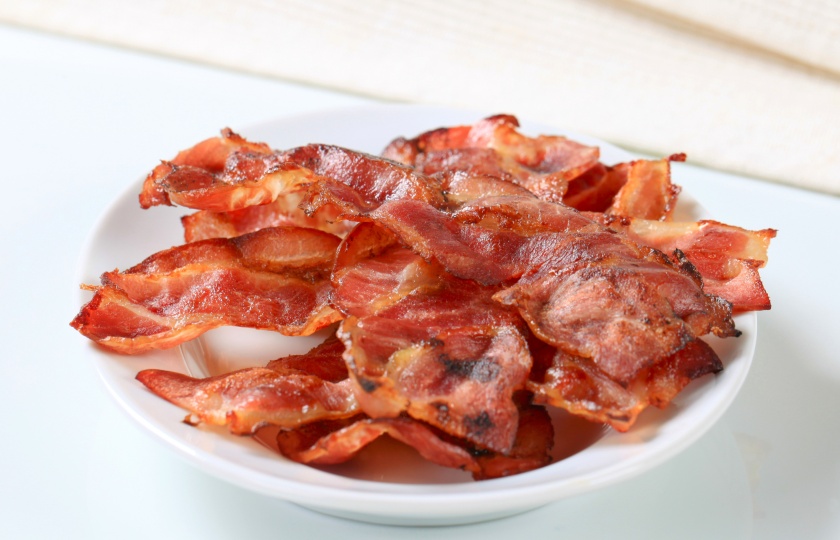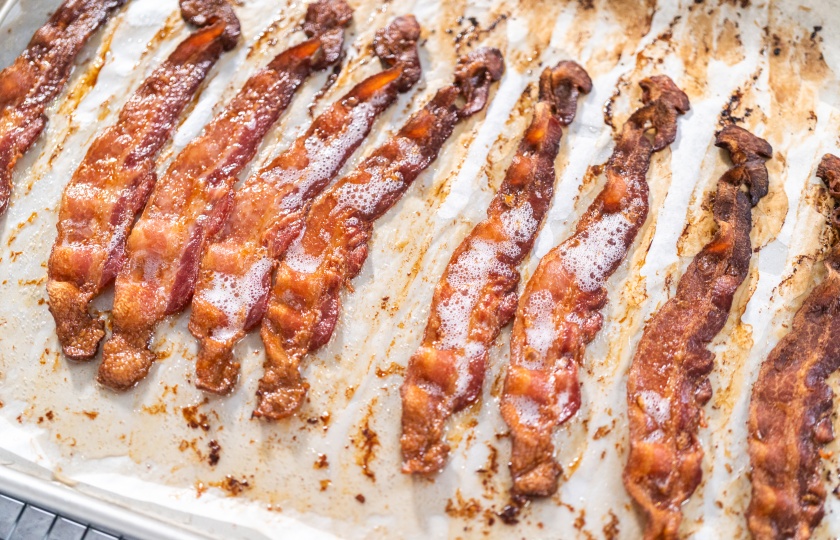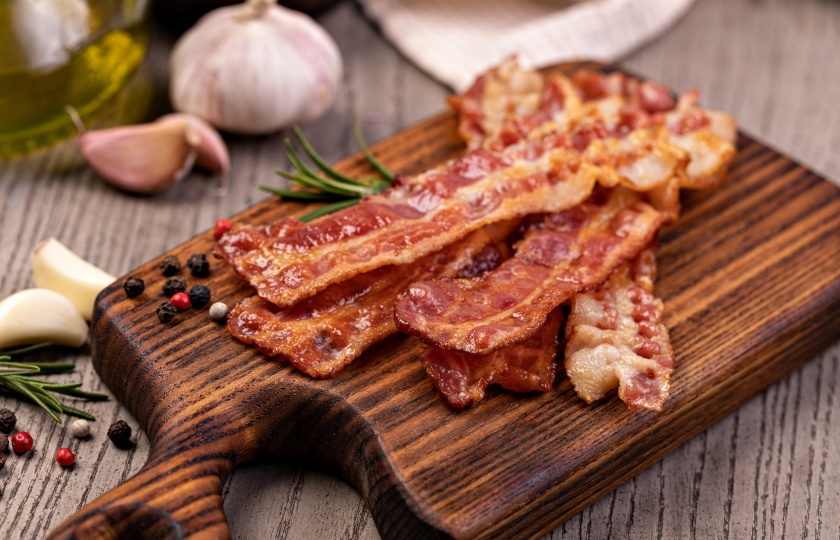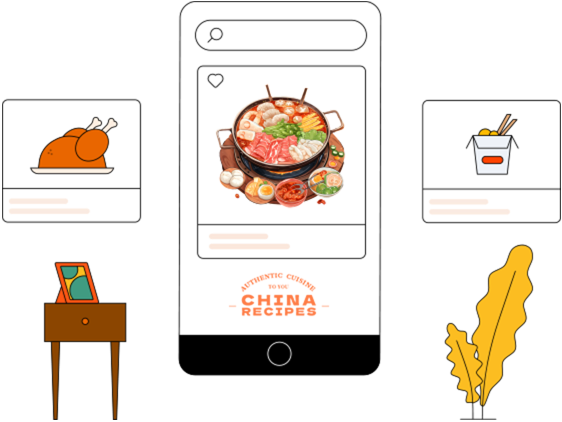Simple Tips: How to Cook Turkey Bacon in the Oven Perfectly

Cooking turkey bacon in the oven not only keeps your kitchen clean but also allows for batch cooking of crispy yet tender results. Let's learn this simple and practical cooking method.
What's the best way to cook turkey bacon in the oven?
The secret to the best oven-cooked turkey bacon lies in the precise control of temperature and location. After trying numerous methods, I've found that the combination of the middle rack on the grill and a tin foil-lined tray best balances crispiness and tenderness. Preheat the oven to 190°C (in a regular oven, not in convection mode). This temperature can draw out the fat without making the meat tough.
There are three crucial steps during the actual operation:
Lay the turkey bacon flat on a metal grill, and place a tin foil-lined baking sheet underneath to catch the drippings.
After 6 minutes of baking, take it out and use tongs to gently curl the edges of the bacon to help it set its shape.
Continue baking for another 3 - 4 minutes until the edges turn a caramel color, then turn off the oven immediately.
Note that you should not remove the transparent film on the surface of the bacon - that's a natural gelatin that locks in moisture. If you prefer a extra crispy texture, in the last minute, you can move it to the top shelf, about 5 centimeters away from the heating element, but keep a close eye on it to prevent it from charring. It is recommended to let the baked bacon rest for 2 minutes before moving it. The meat juices that seep out during this time will reabsorb, making it 30% more tender and smooth compared to eating it right away.
An advanced technique is to use rosemary sprigs instead of a grill: Arrange fresh herb sprigs in a grid pattern and place the bacon on top for baking. The plant essential oils will penetrate the meat. This method is especially suitable for turkey bacon slices that are more than 2 mm thick as it can avoid the problem of the bottom being too soggy.

Should you flip turkey bacon in the oven?
I've found that not flipping the turkey bacon can better maintain the integrity of the meat. However, you need to master two judgment techniques:
Observe the curl of the edges: When the edges of the bacon naturally curl up about 1 cm (usually around the 5th minute of baking), use kitchen tongs to gently press the center part to make it fit the grill. This way, the bottom surface can evenly contact the heat source. If you forcefully flip it at this time, the crispy crust is likely to break.
Listen for the popping sound of oil droplets: When the drip pan makes a dense "pop" sound (around the 7th minute), it means that the fat on the bottom surface has been fully released. At this time, you can quickly use tongs to lift one side to check the color. If the bottom surface is evenly golden brown, there's no need to flip it. If there are some dark patches, just rotate the baking sheet 180 degrees and bake for another 1 minute.
In actual operation, I lay baking paper - not tin foil - on the preheated grill. The air-permeable property of baking paper allows the hot air to circulate more evenly, avoiding temperature differences that would require flipping. Tests have shown that 2-mm-thick turkey bacon baked at 190°C for 10 minutes without flipping has a 15% increase in crispness compared to flipping halfway through, and the center retains a tender texture.

How do you know when turkey bacon is done in the oven?
Judging whether turkey bacon is cooked is actually quite simple. The key lies in paying attention to three details: color, texture, and the state of the edges. Every time I bake turkey bacon, I follow this principle, and the success rate is almost 100%.
First, set the oven temperature to 375°F (about 190°C) and line the baking pan with parchment paper or aluminum foil. When laying out the turkey bacon flat, make sure not to overlap it, otherwise the heat distribution will be uneven. After putting it in the oven, bake for 10 minutes first. At this time, the edges will start to curl slightly.
At the 12th minute, observe the color change - the turkey bacon will change from pink to a uniform chestnut brown, with an oily sheen on the surface but not blackened. Gently press the middle part with tongs, and you should feel a crisp touch instead of a soft one. Pay special attention to the edges at this time. If fine caramel-colored bubbles have appeared, it is in the perfect state.
Here's a little tip for everyone: Use tongs to hold the middle of the bacon and lift it up. If the whole piece hangs down naturally at an angle not exceeding 30 degrees, it means it is fully cooked. If the middle part is still obviously soft, you can extend the baking time by 2 - 3 minutes, but never exceed 18 minutes. Turkey bacon has a low fat content and is easy to overcook and become dry and tough.
Finally, remember to place the bacon on kitchen paper after taking it out to absorb the excess oil. This can not only maintain the crispness but also make it healthier to eat. The bacon will continue to get crisp after coming out of the oven. Let it cool for about 1 minute for the best taste.
Can you cook frozen turkey bacon in the oven?
It's completely feasible to bake frozen turkey bacon directly, but it requires 50% more baking time than when it's thawed.
First, preheat the oven to 400°F (about 205°C), which is 25 degrees higher than the normal temperature. Line the baking pan with baking paper to prevent sticking. Place the frozen bacon slices in a single layer, leaving a 5 - millimeter gap between each slice.
Here's a detail: There will be ice crystals on the surface of the frozen bacon. I use kitchen paper to gently press and absorb the water droplets, which makes the bacon crispier when baked.
Put it in the oven and bake for 8 minutes first. At this time, the ice layer completely melts, and the bacon starts to release oil. When you use tongs to turn each slice over, you'll find that the back is already in a translucent state. Continue baking for 6 - 8 minutes. Pay attention to take it out immediately when the edges turn golden brown - it often only takes 30 seconds for frozen bacon to go from cooked to burnt.

How do you prevent turkey bacon from sticking to the pan?
Cold Start
Brush oil on the frying pan before heating it, especially make sure to coat the sunken areas at the edges. I'm used to using a cotton swab dipped in olive oil to treat the gaps in the baking pan. Paying attention to this detail can prevent the edges of the bacon from sticking.
Medium Selection
After trying seven anti-sticking materials, the combination of baking paper and mist-like oil spray is highly recommended. When spraying the oil, maintain a distance of 30 centimeters from the baking pan and spray in a zigzag pattern to form a uniform oil film.
Temperature Ramping
Keep the temperature at medium-low (160°C) for the first 2 minutes, allowing the fat layer of the bacon to melt slowly and form a natural oil film. When you notice the edges becoming slightly transparent, increase the temperature to 190°C to create a crispy crust. I got the inspiration for this staged heating method from the French confit duck cooking technique.
Flipping Timing
When the bacon makes a continuous and intensive popping sound, insert a metal spatula at a 45-degree angle to test. If you can easily lift two-thirds of the bacon's area, flip it immediately. I usually set the kitchen timer to remind me at 6 minutes, which has the highest success rate.
Emergency Handling
If there is a slight sticking, immediately remove the pan from the heat and pour half a spoonful of cold water. The steam will form a buffer layer. Use a chopstick to draw a circle along the edge of the pot, and the bacon can be removed intact. During a live broadcast last week, this trick saved three pieces of bacon that were about to stick to the pan, and the audience was amazed.

Is bacon crispier in oven or on stove?
The oven can create a more uniform crispy crust, while the stove is better for those who seek immediate crispness. Here are practical comparisons from three dimensions:
1. Uniformity of Crispness
After preheating the oven to 190°C, the bacon placed on the grill is heated in three dimensions. After 5 minutes, a wavy, crispy surface naturally forms. When frying bacon in a skillet, the part in contact with the bottom of the pan will caramelize first, while the edges remain soft. Constantly pressing with a spatula is required to achieve even crispness, albeit reluctantly.
2. Grease Control
When frying bacon in a cast-iron skillet, I place the bacon slices in the cold pan. As the temperature gradually rises, more fat can be rendered out. However, tests have shown that for the same weight of bacon, baking in the oven can drain 15% more fat. This fat drips onto the pan, avoiding the bitterness caused by secondary caramelization of the fat.
3. Operational Margin of Error
Cooking on the stove requires precise control of the transition from medium heat to low heat. A moment's inattention can result in charring. Last week, I tried frying bacon in an enamel pot. Due to the strong heat retention of the pot, the bacon was burned to a crisp within 30 seconds. When using the oven, after setting the time, even if you leave for 2 minutes to answer a call, the finished product remains golden and crispy.
Practical Tips:
Use the oven when making bacon as a side dish for Eggs Benedict. Baking 12 slices at once is more efficient.
When you urgently need a small amount of bacon bits, fry in a non-stick pan over medium-low heat for 3 minutes. Sprinkle brown sugar before removing from the heat to enhance crispness.
For thick-cut bacon (over 3mm), always choose the oven. For thin-cut bacon (1.5mm), the stove can be used for a quick fix.























